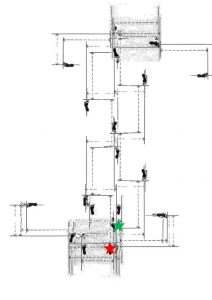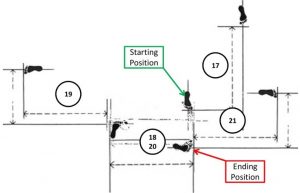Dane Canton, III Dan, Southern Cross Taekwon-Do Academy.
One of the first rules we are told when performing patterns is that all patterns must begin and end on the same spot. In fact, General Choi wrote this as his first rule for patterns:
“1. Pattern should begin and end at exactly the same spot. This will indicate the performer’s accuracy.” – General Choi Hong Hi, Condensed Encyclopaedia, 1999 ed. Page 524.
This works well for most patterns but one that does not conform is the second pattern we learn. If performed correctly, the Taekwon-Doin will end up behind their starting point in Dan-Gun Tul.
I have mapped out each movement so you can see where this happens. I have taken stances from the Encyclopaedia and made sure that all three different stances are the same size, in relation to each other. For movements that involve pivoting or turning, I have overlapped the ball of the appropriate foot to simulate correct pivoting. The green star is the starting position of the right foot and the red star is where the right foot finishes. According to General Choi’s rule, these stars should overlap, but as you can see, they do not.

The map is a little bit hard to read, due to the nature of the images (taken from the Encyclopaedia) but you’ll notice that at movement 17 (the final walking stance outer forearm rising block before turning into the L-stance knifehand outward strike) the right foot is on the starting position. Because of the two L-stances following this (movements 18 and 20) the performer finishes behind their starting position. I have included a close-up version of this section that shows movements 17 to 21 clearly. As you can see, the performer should end up approximately one and a half foot lengths behind the starting position. Interestingly, if we changed movements 18 and 20 from L-stances to sitting stances, we would finish on the correct spot. However, it would be more awkward to go from a sitting stance into a walking stance, particularly for lower grades.

Ultimately, I believe we should keep Dan-Gun Tul as prescribed by General Choi and instead use it as a teaching moment for our lower grades. Remind your students that all patterns should start and finish on the same spot and then have them perform Dan-Gun Tul. At the end, ask how many of them ended up on the same spot. Usually you will have at least a few hands raised, particularly if the students are younger. Then explain that Dan-Gun Tul is the exception to the rule and that if they ended up on the same spot, their stances are probably incorrect and the ones who ended up behind their spots are probably correct. This will make students pay closer attention to their stances.
